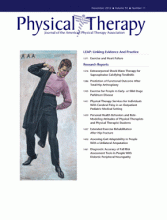Abstract
Background Exercise confers short-term benefits for individuals with Parkinson disease (PD).
Objective The purpose of the study was to compare short- and long-term responses among 2 supervised exercise programs and a home-based control exercise program.
Design The 16-month randomized controlled exercise intervention investigated 3 exercise approaches: flexibility/balance/function exercise (FBF), supervised aerobic exercise (AE), and home-based exercise (control).
Setting This study was conducted in outpatient clinics.
Patients The participants were 121 individuals with PD (Hoehn & Yahr stages 1–3).
Interventions The FBF program (individualized spinal and extremity flexibility exercises followed by group balance/functional training) was supervised by a physical therapist. The AE program (using a treadmill, bike, or elliptical trainer) was supervised by an exercise trainer. Supervision was provided 3 days per week for 4 months, and then monthly (16 months total). The control group participants exercised at home using the National Parkinson Foundation Fitness Counts program, with 1 supervised, clinic-based group session per month.
Measurements Outcomes, obtained by blinded assessors, were determined at 4, 10, and 16 months. The primary outcome measures were overall physical function (Continuous Scale—Physical Functional Performance [CS-PFP]), balance (Functional Reach Test [FRT]), and walking economy (oxygen uptake [mL/kg/min]). Secondary outcome measures were symptom severity (Unified Parkinson's Disease Rating Scale [UPDRS] activities of daily living [ADL] and motor subscales) and quality of life (39-item Parkinson's Disease Quality of Life Scale [PDQ-39]).
Results Of the 121 participants, 86.8%, 82.6%, and 79.3% completed 4, 10, and 16 months, respectively, of the intervention. At 4 months, improvement in CS-PFP scores was greater in the FBF group than in the control group (mean difference=4.3, 95% confidence interval [CI]=1.2 to 7.3) and the AE group (mean difference=3.1, 95% CI=0.0 to 6.2). Balance was not different among groups at any time point. Walking economy improved in the AE group compared with the FBF group at 4 months (mean difference=−1.2, 95% CI=−1.9 to −0.5), 10 months (mean difference=−1.2, 95% CI=−1.9 to −0.5), and 16 months (mean difference=−1.7, 95% CI=−2.5 to −1.0). The only secondary outcome that showed significant differences was UPDRS ADL subscale scores: the FBF group performed better than the control group at 4 months (mean difference=−1.47, 95% CI=−2.79 to −0.15) and 16 months (mean difference=−1.95, 95% CI=−3.84 to −0.08).
Limitations Absence of a non-exercise control group was a limitation of the study.
Conclusions Findings demonstrated overall functional benefits at 4 months in the FBF group and improved walking economy (up to 16 months) in the AE group.
Footnotes
Dr Schenkman, Dr Schwartz, and Dr Kohrt provided concept/idea/research design. Dr Schenkman, Dr Barón, Dr Schwartz, and Dr Kohrt provided writing. Dr Hall, Dr Schwartz, Ms Mettler, and Dr Kohrt provided data collection. Dr Schenkman, Dr Barón, Dr Schwartz, Ms Mettler, and Dr Kohrt provided data analysis. Dr Schenkman and Ms Mettler provided project management. Dr Schenkman provided fund procurement. Dr Schwartz and Dr Kohrt provided facilities/equipment. Ms Mettler provided clerical support. Dr Hall provided consultation (including review of manuscript before submission). The authors gratefully acknowledge members of the research team who made this study possible and the participants with Parkinson disease, without whom there would have been no study.
This study was approved by the Institutional Review Board of the University of Colorado.
This work was supported by grants from the National Institutes of Health (R01 HD043770-04, Colorado CTSI TL1 RR025778, P30 DK048520, and NS052487) and the Parkinson's Disease Foundation.
This trial is registered at ClinTrials.gov: NCT01257945.
- Received December 17, 2011.
- Accepted July 10, 2012.












